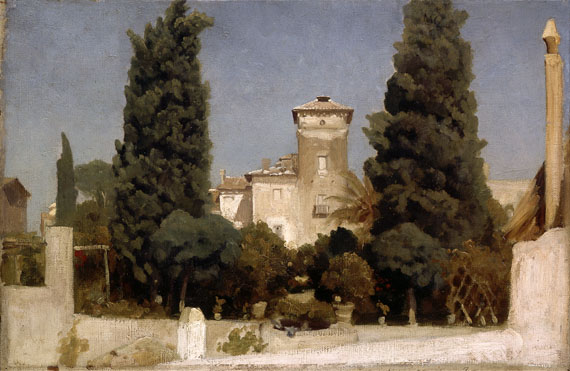
Issued December 2007
15 December – 6 April 2008
The National Gallery, London
Room 1
Admission Free
By the early 19th century, the practice of painting oil sketches in the open air was widespread across Europe. Oil sketching was seen primarily as training for the hand and eye, with artists exhorted to paint quickly to capture fleeting effects of light and atmosphere.
In the space of just two hours, some artists were able to make works of tremendous freshness and beauty. Artists from Britain, France, Italy, Germany, Belgium and Scandinavia were particularly attracted to the Roman Campagna but also found inspiration in their native lands.
These sketches were rarely intended for public exhibition. Painted on small-scale wooden panels or paper, they were piled in the corner of the artist’s studio, little valued and largely ignored until generations later. This National Gallery Room 1 exhibition celebrates the rediscovery and re-evaluation of these remarkable works of art, drawing on one of the finest collections of oil sketches in the world.
Since 1999, when the renowned Gere collection was entrusted to the National Gallery on long-term loan, the Gallery has become one of the most important destinations for the study of this now unusual art form.
The challenge of attributing individual sketches has been a key concern for art historians at the Gallery. Sketches were almost never signed and close-knit circles of artists frequently painted in a remarkably similar manner.
When the Gere collection was first displayed at the National Gallery in the summer of 1999, the curators received several letters from members of the public disputing the subject and authorship given for several important works. Experts had speculated that Lord Frederic Leighton’s Coastal Landscape was inspired by a site in Cornwall. That was until resident Mark Collins realised that Leighton’s stretch of coastline precisely matched a photograph he had taken near Ventnor on the Isle of Wight.
Even more remarkable was the discovery by American painter, Susan Bull Riley, who recognised that a Landscape with Cumulus Clouds – confidently attributed by experts to Gilles-François-Joseph Closson – in fact bore a striking resemblance to a painting in the V&A, 'Landscape near Haarlem', 1839, by the Dutch painter Andreas Schelfhout (1787–1870). Thanks to the expert eyes of these visitors, both works will now go on display with their amended attributions for the first time.
Featuring around 50 small-scale works, the exhibition will include Théodore Rousseau’s The Valley of St-Vincent, one of two landscape oil sketches purchased by the National Gallery in 1918 at the Paris sale of Edgar Degas’s private collection. Also on display will be scenes by such admired figures as Pierre-Henri de Valenciennes, Simon Denis, Giovanni-Battista Camuccini and eight works by Lord Leighton (1830–1896), who was President of the Royal Academy for eighteen years and the first artist to be raised to the peerage in Great Britain.
In the latter part of the 19th century the immediacy and spontaneity of oil-sketching was adopted by the Impressionists, including Claude Monet and Edgar Degas, who exhibited their own sketch-like paintings as finished pictures. Meanwhile the importance of oil-sketching in academic artistic practice declined.
Notes to Editors
The Gere Collection
The collecting of landscape oil sketches was pioneered by distinguished art historians, John and Charlotte Gere, in the 1950s. Today the Gere Collection numbers some 70 works forming one of the most comprehensive groups of its kind. The collection has been on long-term loan to the National Gallery since 1999.
For further press information please contact:
Tom Almeroth-Williams on 020 7747 2512 or e-mail thomas.almerothwilliams@ng-london.org.uk
